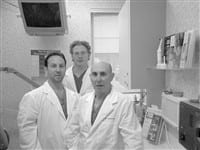A Changing Landscape
The health care landscape has changed considerably over the past decade, with a number of expansion and new-building projects. The biggest, by far, is Baystate Medical Center’s new Hospital of the Future, a $251 million, 650,000-square-foot facility now taking shape on the Baystate campus (left). Above, a computer model of the Hospital of the Future, which is projected to be completed by the end of 2011 and opened in 2012.
Cooley Dickinson Hospital opened its new patient building and Kittredge Surgery Center in 2007. The $50 million complex provides easier flow in the operating rooms, easier placement of patients, and a state-of-the-art facility for specialists. Patients benefit from increased privacy, more streamlined nursing care, and a more pleasant environment for friends and relatives.
The Mercy Medical Center campus was expanded in 2004 with the opening of the Sr. Caritas Cancer Center. The 13,000-square-foot facility was built at a cost of $11.5 million. The hospital later launched a two-phase, $16 million overhaul of its ICU and surgical facilities.
The new entrance to Holyoke Medical Center was part of a major expansion project completed in 2003. It included new operating rooms and endoscopy rooms. Other areas included in the project were the Patient Registration department, front lobby, recovery rooms, Laboratory, Cardiology, Anesthesia, and Medical Records, as well as the hospital’s gift and coffee shop.
In June 2008, Wing Memorial Hospital opened a 58,000-square-foot addition named the Country Bank Pavilion, which replaced the inpatient, ICU, and surgery units. Technologically, the new addition includes three state-of-the-art operating rooms and provides an innovative telemedicine system in the ICU. In September 2009, Wing opened the new Center for Geriatric Psychiatry (CGP), increasing its number of acute-care beds from 59 to 74, representing a 25{06cf2b9696b159f874511d23dbc893eb1ac83014175ed30550cfff22781411e5} increase.
Another new addition to the landscape was Baystate Health’s D’Amour Center for Cancer Care on Main Street in Springfield’s North End. The three-story, 65,000-square-foot facility opened in 2004. It was designed with the guiding principle of patient-centered care. To achieve this, the architectural layout defines patient and provider spaces clearly in order to have a peaceful, healing environment for patients, while creating collaborative, efficient workspaces for the physician teams.
There were many other changes to come to Main Street in Springfield over the past decade. Among them were projects to revitalize several old manufacturing buildings. At left, a part of the old Van Norman complex was renovated into the Medical Arts & Conference Center. At right, a portion of the Moore Drop Forge complex was rehabbed into the new home of the Pioneer Valley chapter of the American Red Cross.












Comments are closed.